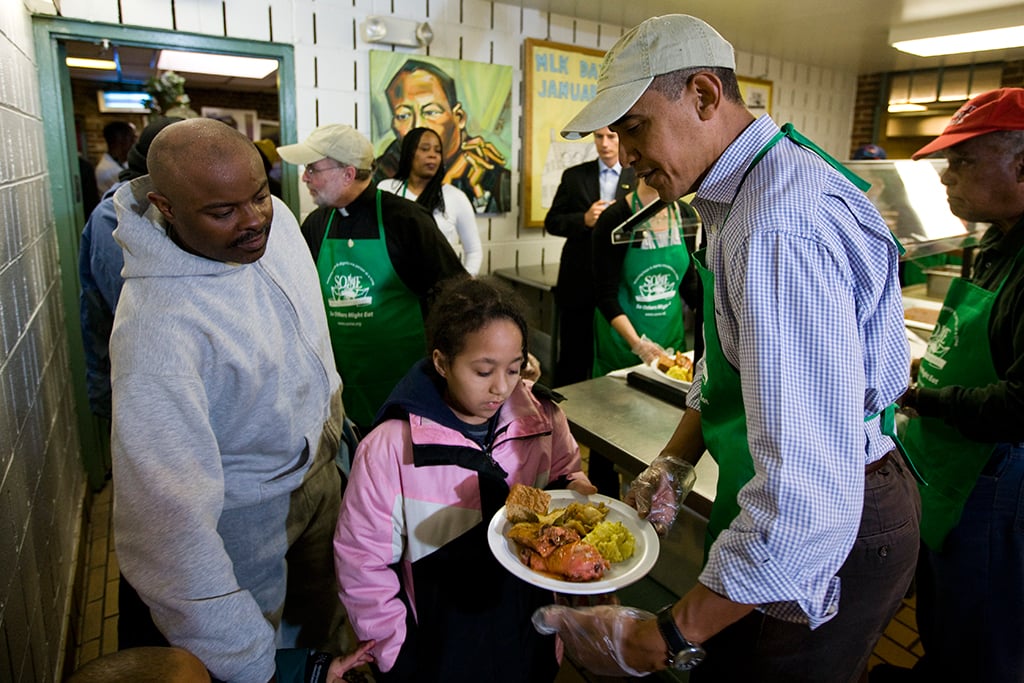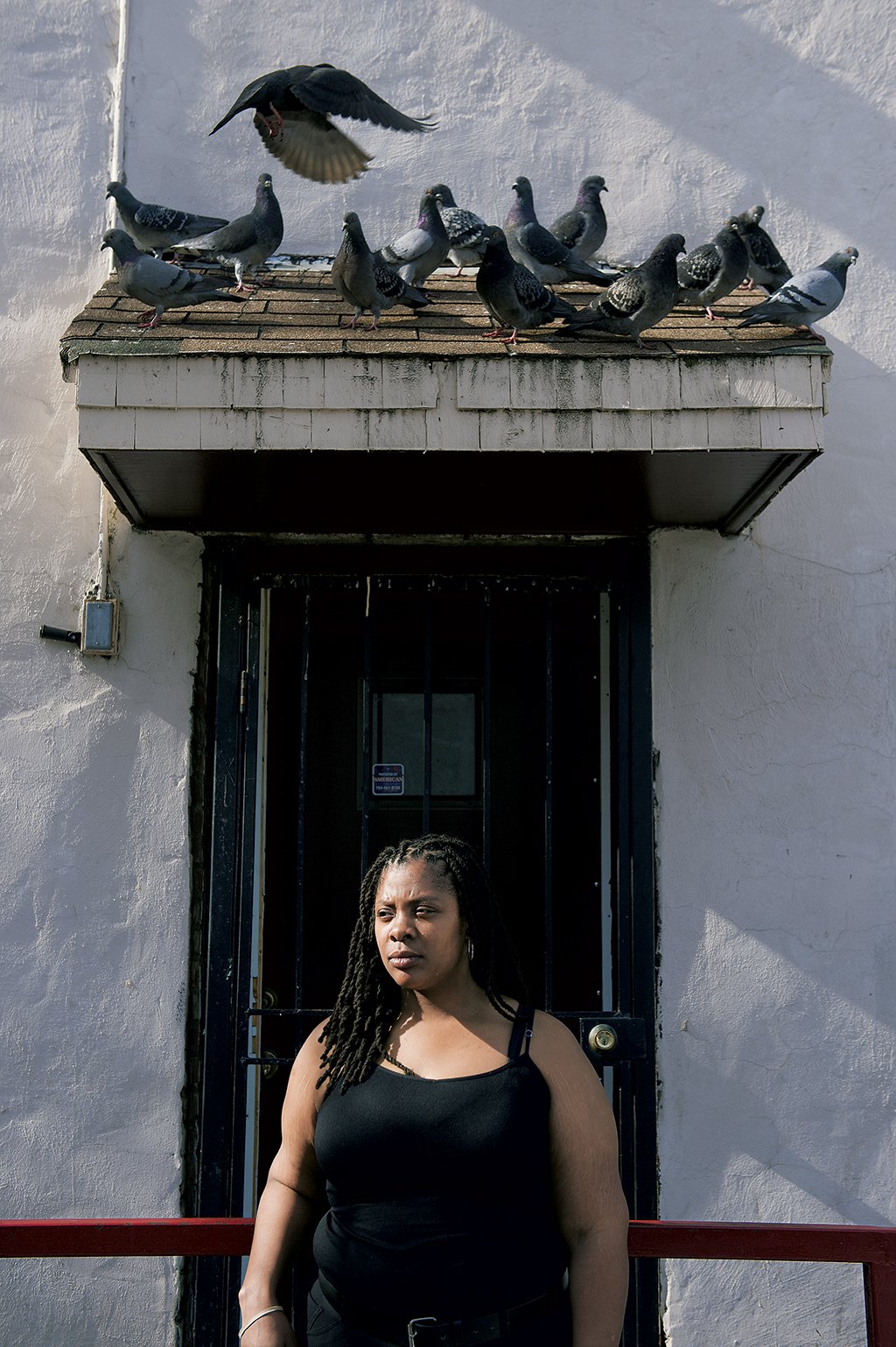For most of her adult life, Charisma Brown was homeless—couch-surfing among family and friends and struggling with bipolar disorder and addiction. But early last year, she moved into a rowhouse in DC’s gentrifying Truxton Circle, where market-rate properties can approach $1 million. It was her first home, all 1,300 square feet.
Brown puts a third of her Social Security income toward the rent; the rest is government-subsidized. Her landlord is the nonprofit So Others Might Eat, also known as SOME, which vetted her before she was allowed to move in. She passed a drug test and reference check. She also agreed to SOME’s “zero tolerance” policy, which prohibits renters from using illegal drugs, alcohol, or marijuana.
Brown didn’t hesitate about committing to the policy. The 30-year-old hit her lowest point three years ago when her son and daughter went into foster care. Since then, she’s kicked her PCP habit, gotten the right medications, and begun seeing a therapist. Sobriety, Brown says, “is not a game for me.”
For a time, she was doing well. Now that she had her own home, she felt sure she was a step closer to getting her kids back, and she got them beds for the overnight stays she hoped the judge would soon allow. Last summer, though, all that progress was threatened. An employee of SOME came by the rowhouse and wrote her up for a hand-rolled cigarette he believed to be marijuana (it was never confiscated or tested) and for having a vodka bottle, which she says she was using as a flower vase.
Brown didn’t fail a drug or alcohol test; if she had, she would have been in clear violation of the zero-tolerance rule. Nonetheless, she says she was instructed to sign a move-out agreement stating she would leave within 30 days. When she refused to pack up, SOME took her to court and began proceedings to evict her.
“I’ve never seen another landlord try to evict someone for having an empty bottle or a glass of wine, or any alcohol at all, because it’s lawful to drink,” says Amber Harding of the Washington Legal Clinic for the Homeless, who represents tenants of SOME.
The zero-tolerance policy is unusual in Washington, and housing lawyers will tell you it’s among the strictest they’ve seen. Lately, it’s also become a subject of tension between the social-services community and a beloved local provider, one of the city’s largest charitable suppliers of low-income housing.
The backdrop to the tension is that, while other cities have celebrated declines in their homeless populations, DC’s was climbing until recently. Mayor Muriel Bowser has pledged to end chronic homelessness by 2020. But the fact that one of her city’s most prominent nonprofits maintains unusually rigid housing requirements has underscored an awkward philosophical divide.
Until about a decade ago, zero-tolerance rules were standard practice. Almost all low-income-housing providers imposed a sobriety requirement. This created something of a Catch-22: Homeless people needed to get off the street to get sober, but they weren’t allowed into housing until they were sober. And because relapse is a common stage of recovery, those who managed to get in were often kicked right back out.
The thinking began to change under President George W. Bush. His administration zeroed in on Pathways to Housing, a New York City organization that had pioneered a model called Housing First, in which homeless people were first given permanent homes, then access to treatment and other services. A federally funded study showed that about 80 percent of Housing First participants stayed off the street, compared with roughly 40 percent of those in the old sobriety-based model.
A father said, ‘You’re treating me like a child. I don’t have an addiction problem. I have a beer or two after work.’
The Bush administration also liked the fiscal argument for Housing First. When people have a roof over their heads, they’re less likely to wind up in emergency rooms or taxpayer-funded jails. The spending difference can be staggering. According to Pathways to Housing DC, which opened in 2004, it costs $20,000 to $24,000 a year to subsidize an apartment and provide services for someone in the District, compared with the $40,000 in services required to keep that person alive on the street.
In large part because of numbers like these, Housing First is mainstream policy today. The federal government prioritizes funding for organizations that follow it, and it’s labeled a so-called best practice. “Housing First philosophy is not only successful at accomplishing the end result of a person having their own home, but it’s actually more efficient than we would’ve thought 20 years ago,” says Jennifer Ho, senior adviser to Housing and Urban Development Secretary Julián Castro.
The District adopted Housing First as the citywide standard in 2008. Pathways to Housing DC and Friendship Place, two of the city’s largest providers, adhere without exception. Others, such as Community of Hope, use Housing First in their permanent homes but retain a few transitional housing units for recovering addicts who specifically request a sober environment.
So Others Might Eat was Founded in 1970 by a Roman Catholic priest named Horace McKenna. The interfaith group has 364 paid staff members and 18,800 volunteers and takes in upward of $1 million in donations at its annual gala at the National Building Museum. Its budget for 2016 is more than $26 million.
The nearly 50-year-old Washington institution wields so much clout that, according to its executive director, Richard Gerlach, “new [DC Council members] know: You come and visit SOME. Just like the last three Presidents of the United States have.”
There’s no question that the group does an immense amount of good, including providing hot meals 365 days a year, health care, job training, and addiction-treatment programs, including a residential program that allows mothers to bring their children.
Housing gets the largest chunk of SOME’s budget, more than $8 million in 2016. It owns 21 apartment buildings and single-family homes across DC, providing low-income units for more than 1,000 people. The zero-tolerance rule applies to all, including the nearly 40 percent of residents not recovering from addiction.

The organization is committed to the policy and, even as the political winds have shifted, has stuck by it: In 2015, 26 people lost their SOME housing because of zero-tolerance violations. The logic, says the group’s leadership, is that if one person drinks or uses, neighbors are more likely to start doing so, too.
“It’s to protect everybody else in the building,” says SOME’s president, Father John Adams. “It’s pretty important for the safety of the building. People do love living in a clean-and-sober environment.”
The consequences of that ambition can be severe. Take former resident Shawnee Mason. In 2011, she invited friends and family to her building to celebrate her daughter’s first birthday. Afterward, the SOME property manager informed Mason that she suspected alcohol was present at the party, according to court documents. When Mason refused to move out, eviction proceedings began.
This is where the divergence between the zero-tolerance approach and the Housing First conventional wisdom is starkest. On the one hand, people know what they’re signing on for at a SOME property. On the other, the implications of enforcing that policy can undercut the broader goal.
We’re not going to get them a landlord and make it paved to a golden parachute. We do it for CEOs but not people using.
Brian Carome, SOME’s former director of family housing, recalls feeling as if he were setting up families to fail. “I remember this one father saying, ‘You’re treating me like a child. I don’t have a problem with addiction. I come home. I have a beer or two after work,’ ” says Carome, now executive director of the DC newspaper Street Sense. “I did not see a lot of families deep in the throes of addiction. I saw families who were getting evicted for testing positive for marijuana, where for the most part . . . they were doing everything else they were supposed to do—paying rent, tending to the needs of their children.”
People such as Chanice Little. She works at Drybar in Georgetown and says she agreed to the rule—even though she sometimes smokes pot to relax—because she would have signed anything to get herself and her one-year-old daughter out of DC General, the city’s notoriously unsafe family shelter.
Little had been removed from her mother’s custody at age eight and grew up in foster homes across Washington. Once she aged out of foster care, she struggled to find permanent housing. At 23, she and her then-infant daughter spent a harrowing year at the shelter. Eventually, Little qualified for a subsidized apartment in Weinberg House, a SOME property near Mount Vernon Square.
Within a couple of months of moving in, she was given two random drug tests that came back positive for pot. SOME acted to end her lease. But Little refused to leave. The organization gave her 30 days to correct her behavior. After that period was up, another test came back inconclusive, according to her lawyer; SOME directed her to return home within three hours to retake it. She didn’t. Little says she was stuck at the library, completing a final presentation with classmates from her financial-literacy course. SOME counted the no-show as a failure.
“She was doing everything she could to better her life; they were doing everything they could to derail her, in my eyes,” says Paul Lee, a K Street attorney who manages the pro bono program at Dechert. “Her case was just so extreme.”
Little—who’d gotten out of the public shelter and was saving money from working—is, by most measures in the social-services world, a success story. But if she hadn’t found a lawyer and refused to move out, she may have landed back on the District’s tally of homeless residents.
Lee partnered with Harding, of the Washington Legal Clinic for the Homeless, and discovered that the DC government subsidies for many residents at Weinberg House, including Little, came with a condition: no random drug testing allowed. Harding notified the city that she believed SOME was not complying with District law. Gerlach blames the city for the mess: “There was an error. They approved something in our policy that was not consistent with that law.”
In the end, SOME allowed Little to stay at Weinberg House.

Still, Lee says he’s troubled that when the organization wanted her out, it didn’t suggest other viable places for her and her daughter to go: “They literally circled market-rate apartments on Craigslist for her, and they also suggested she move in with her ex-boyfriend.”
Gerlach says SOME provides guidance and contact information for other possible shelter. Tenants can also apply for SOME’s residential treatment program in West Virginia. “If they’re not willing to stop using, we talk to them about some housing options. We talk to them about Housing First,” he says. “We’re not going to go out and get them a landlord and make it, like, paved to a golden parachute. We do it for CEOs, but we’re not doing it for people that are using.”
In fact, So Others Might Eat has found a way to speed up the eviction process. DC landlords must give residents 30 days to correct a behavior before they can try to throw them out, and the tenant-friendly process often involves months of back-and-forth in court. Following that procedure “could take a year and a half,” Gerlach explains. When SOME gets tenants to sign its move-out agreement and leave, it avoids going to court altogether.
Yet the document has made some of the organization’s staff uncomfortable.
Emily Button, who has spent 11 years working in homeless services and housing, was a SOME program manager at Gasner House in Southeast DC for 2½ years. She says she told more than ten residents to sign the form and that most left without a fight. Mary Duncan was an exception. In December 2013, according to court filings, Button told Duncan that she had failed a drug test and that if she didn’t sign the form, she would have to leave in 72 hours. Duncan signed but later sought legal help.
The experience made Button question her job. She says she felt as if SOME expected her to make residents believe they had no choice but to sign and says she was instructed to say things like “I need to get an agreement in place to specify when you can move out.” After Duncan went to court, Button started to deviate from her usual script: “I was trying to split the difference between following the letter of my job so nobody could say I was insubordinate, and at the same time following ethics so the clients would know not to sign the form.”
She says she’d say, “I don’t want to come between you and any rights that you might have, but we’re asking you to sign this form.”
Button’s bosses took note. She shared with me an e-mail from her supervisor reiterating the importance of the policy and pointing out that she had too many residents refusing to sign the agreements. In the summer of 2014, she left SOME: “I said I feel like it’s not right to know that people have a legal right to stay and then take action intended to cause them to waive their legal right without them realizing it.”
“Are we going to read [noncompliant residents] their absolute legal rights? We’re not going to do that,” Gerlach says, adding that all residents do receive a copy of DC’s Tenant Bill of Rights upon moving in.
The move-out agreements are presented to tenants as optional, Gerlach says. If someone doesn’t want to sign, then SOME follows the court process to evict the person.
When you stack the city’s homeless-housing providers against one another and look at whose residents are least likely to land back on the street, SOME holds its own with the Housing First community. In 2015, Friendship Place and Community of Hope kept 99 and 100 percent of their permanent residents housed; for Pathways to Housing, the result that year was 90 percent. At SOME, it was almost 95 percent.
This isn’t an apples-to-apples comparison, however, because Housing First groups prioritize the neediest cases, while SOME prescreens prospective tenants, reviewing police background checks and requiring references before admitting them to its buildings.

A look at the bigger picture shows some encouraging gains toward ending chronic homelessness, as Mayor Bowser wants to do. Last year, 34 percent more homeless individuals and 16 percent more families moved into permanent housing compared with 2014, as did 49 percent more homeless veterans. Meanwhile, DC’s most recent count of people living on the streets and in shelters showed a decline of 5.8 percent.
Still, rents in the District are among the highest in the country, and the city is in the midst of an affordable-housing crisis. To Housing First advocates, this proves DC can’t afford programs that allow people to land back on the street. To Gerlach, it proves a need for a “big tent” approach, with housing providers supplying a variety of different models. “Fund them all!” he wrote in an e-mail following our interview.
As much as SOME owns its policies, there’s no question they’ve left the organization in a lonely spot politically. Mayor Bowser’s strategic plan to end homelessness states: “We must embrace the Housing First philosophy as a system.”
Gerlach says he was worried enough about SOME’s funding that he took it upon himself to testify before the DC Council last spring—a task he would normally delegate to his advocacy staff. Father Adams adds that he has paid a personal visit to every council member’s office to push for SOME’s policies.
Charisma Brown is still trying to stay on the right side of them. She got rid of her vodka bottle turned flower vase and reached a settlement with her landlord in October. Under the terms, she gets to stay in the Truxton Circle rowhouse. But if she violates the zero-tolerance rule again within the year, SOME can bring her back to court. Because she had already signed the move-out agreement, it was about the best result she could have hoped for.
This article appears in the March 2016 issue of Washingtonian.



















